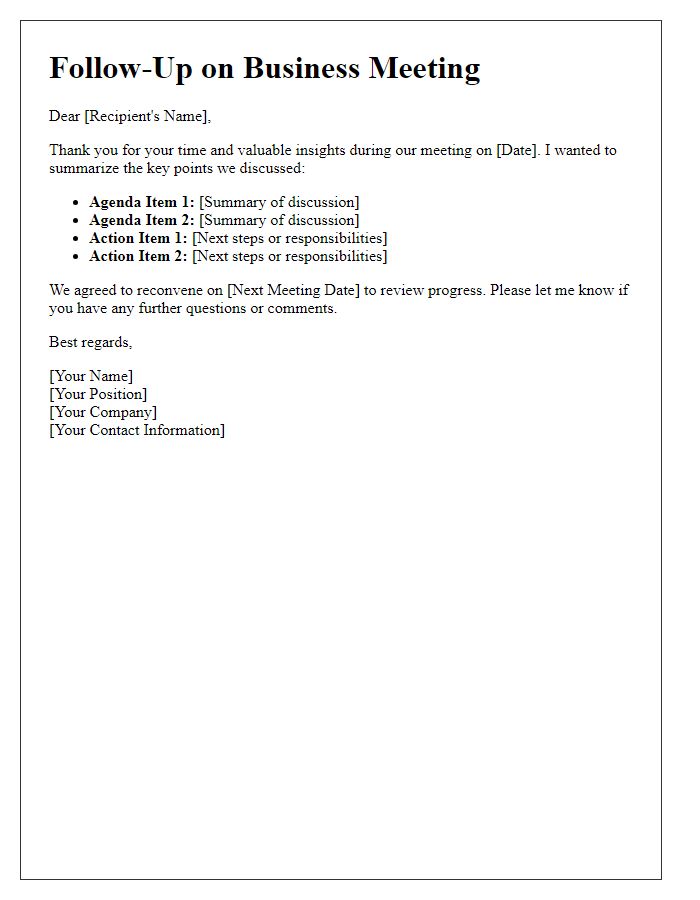Have you ever found yourself in a business meeting and thought, "What's next?" Following up after a meeting can be a game changer, as it reinforces connections and keeps the momentum going. A well-crafted follow-up letter not only highlights key discussion points but also reiterates your enthusiasm for potential collaborations. Curious about how to create the perfect follow-up letter? Keep reading to find out!

Professional Tone
A follow-up after a business meeting can solidify relationships and clarify action items. It's essential to highlight key points discussed during the meeting, such as project timelines, responsibilities, and upcoming deadlines. Reiterate commitments made by participants to ensure accountability. Including specific names, dates, and figures can reinforce clarity. Additionally, a reminder for the next steps or future meetings establishes a structured approach to progress. Maintaining professionalism and gratitude enhances rapport and encourages collaborative efforts moving forward in the business relationship.
Meeting Recap
Following the recent business meeting held at the Downtown Conference Center, key discussions revolved around project timelines, budget allocations, and team roles. Attendees, including project managers from various departments, emphasized the importance of adhering to the scheduled milestones, with specific deadlines set for the next quarter. The budget review highlighted a 10% increase in funding for development activities, necessitating careful planning to ensure financial efficiency. Team role delineation was also clarified, with marketing and operations departments tasked with collaboration on upcoming campaigns to enhance product visibility. Overall, the meeting fostered a collaborative atmosphere, establishing clear objectives moving forward into the project phase.
Action Items
In business meetings, action items serve as crucial components, outlining specific tasks assigned to individuals or teams for follow-up. These tasks often stem from significant discussions held among participants, typically in corporate settings such as quarterly planning sessions or project kick-off meetings. Each action item must include a detailed description, responsible party, and deadline to ensure accountability. For instance, a marketing manager may be tasked with developing a new advertising strategy by the end of Q3 2023, while a sales analyst might analyze customer feedback for a new product launch by the upcoming meeting in November 2023. Clear communication and a structured approach to documenting these action items can enhance workflow and drive project success.
Appreciation for Attendance
Following the recent business meeting held in Conference Room B at the Downtown Corporate Center on October 15, 2023, I would like to express my sincere appreciation for your attendance and active participation. Your insights regarding market strategies and growth opportunities for our ongoing project, Project Phoenix, are invaluable as we aim to enhance collaboration among our teams. The discussions on budget allocations and timelines for the upcoming quarter were particularly enlightening. Your presence significantly contributed to a productive atmosphere, fostering innovation and teamwork as we move forward. Thank you for your continued support and dedication to our shared goals.
Contact Information
After a successful business meeting, following up on key discussion points can enhance professional relationships and promote collaboration. Clear communication is essential. Include the contact information of all relevant participants, such as names, phone numbers, email addresses, and job titles. Ensure details are accurate for seamless future correspondence. This step fosters continued engagement and signals professionalism. Additionally, summarizing action items discussed during the meeting can provide clarity and reinforce commitment to shared goals.
Letter Template For Business Meeting Follow-Up Samples
Letter template of business meeting follow-up for partnership opportunities.

Letter template of business meeting follow-up addressing client concerns.












Comments